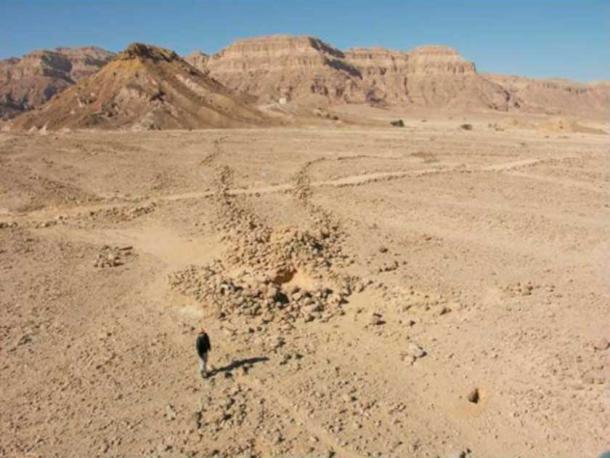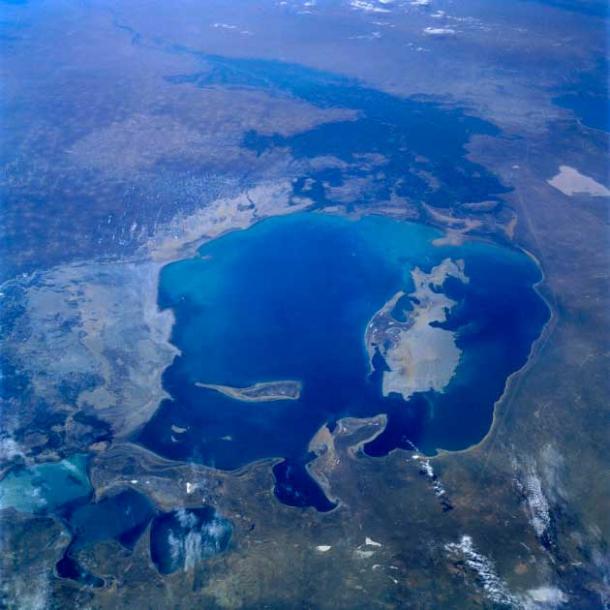Desert Kites: Ancient Hunters Built Massive Death Traps for Animals
Located on the Ustyurt plateau spanning Kazakhstan, Uzbekistan and Turkmenistan are some puzzling ancient structures - or what remains of them. The plateau is a dry, clay desert which stretches a staggering 200,000 square miles and receives less than 5.1 inches (13 centimeters) of rainfall a year.
In the 1920s, a Royal Air Force pilot first spotted these ancient structures when flying over this desert. Dubbed desert kites for their shape, these ruins have been inspiring questions ever since, and archaeologists are still putting the pieces together. What was the purpose of these ancient structures? Who built them and why in such an unusual shape?
The Discovery of the Desert Kites
Of course, the Arab desert tribes known as Bedouins were aware of these structures for thousands of years, but their discovery by the Western world has prompted extensive research and fieldwork.
The desert kites were characterized by long, arrow-like lines of stones, which would lead to an enclosed area that would have once housed pits. These complex geometric earthworks are barely noticeable from the ground, but from above, they seem to make more sense. The archaeologist Shamil Amirov has been using satellite imagery to map the desert kites in western Uzbekistan. When talking to National Geographic in 2016, he stated:
“Most are shaped like arrows. We have found them in chains across the migration trails of antelopes. They probably directed thousands of animals into killing pits.”
Thanks to technological developments in aerial photography and satellite data, these desert kites can now be located in other areas across the world. According to National Geographic, as of 2016 there had been 5,000 structures logged.
Furthermore, a French research project called Global Kites has compiled a large number of satellite images of these ruins, 4,600 to be exact. These kites have been observed in the Levant, Saudi Arabia, Armenia, Yemen, and the Ustyurt plateau.
There is also evidence of these kites in Europe which date to the Mesolithic and Neolithic periods, and there is further evidence of similar structures known as drive lines in North America.
What has made the exploration of the sites harder today is that some of the traps have been built over with other, newer structures, or they have been eroded and submerged. Desert kites are also found in complex terrain.
The areas they are built in seem to have some consensus to them. The desert kites are very rarely found on sloping terrain, in mountainous regions or in endorheic basins. The builders of these ancient structures tended to favor more open landscape, clear of vegetation and rocks.
They also preferred particular climates. Desert kites don’t tend to appear in humid climates or in some hyper-arid places. It is also thought that the Holocene climate changes may have had some influence on their usage.
- More Ancient Mysterious Stone Structures Found in Saudi Arabia
- The Works of Old Men: Geoglyphs of the Middle East

A desert kite in the Negev, south of Israel, dated 8,300 - 4,500 BC (Guy Baroz / CC BY SA 3.0)
When Were They Built?
According to Amirov, desert kites were built over a span of more than a thousand years. Although dating the structures is difficult, radiocarbon dating has now suggested that some of these structures are more than 2,000 years old. What is even more staggering is that there is evidence that some of them were still used as hunting pens until the middle of the 20th century!
According to Remy Crassard, a French anthropologist, some of the oldest desert kites exist in Jordan. Talking to the Green Prophet in 2020, Crassard stated that:
“Until now, we can estimate the use of the kites in Jordan and most probably in the neighboring regions to the end of the Neolithic, which was around 8000 years ago.”
What Were the Desert Kites Used For?
Archaeologists have been pondering this question since they found the desert kites in the 1920s. Originally, it was thought that the kites may have represented the border between what were the Roman and the Sassanian empires in the Syrian Desert. Another theory posited that they could be water channels. Some suggested that they may have served as living quarters or cultic sites. However, it is now generally believed that the structures were used for trapping animals.
Archaeological remains suggest that some of the desert kites were used as traps for capturing game animals like gazelles, onagers, Arabian oryxes, hartebeests and ostriches. It is thought that they were also used for the domestication of animals, as well as their slaughter in Neolithic times. According to Amirov:
“We’re sure they were hunting traps because herders still used them here until very recently, a century ago.”
- Some Giant Geoglyphs in Jordan are Older than the World Famous Nazca Lines
- Mysterious Ancient Wall Extending Over 150km Investigated in Jordan

Desert kites were used to herd and slaughter many animals, like the Arabian oryx (Charles J Sharp / CC BY SA 3.0)
While they all have a general kite-like shape, there are some variations. There are bag-shaped kites, star-shaped kites, and clover-leafed kites. What all the kites shared, however, were the lines of two walls that converged into an enclosure with attached cells.
Aside from animal remains, there have been no other archaeological finds which tell anything about the people who constructed and lived near these traps. As stated in a report published in Quaternary International:
“their size and the almost total absence of archaeological artifacts render any conclusions on their study very approximate.”
This lack of consensus is a result of the lack of physical evidence, and disputes over the little evidence that does exist. Furthermore, the fact that these hunting traditions are now extinct makes it hard to piece together the exact nature of the desert kites and how they were used.
Hunting Whole Herds at a Time
Desert kites litter the landscape in what can seem an overwhelming number; however, archaeologists are now able to conduct statistical studies to figure out the exact nature of their existence. Crassard and his team, for example, have recorded more than 6,000 from Saudi Arabia to Uzbekistan.
The sheer number of these kites across hundreds of miles east of the Aral Sea has led archaeologists to the conclusion that there must have been a large collective hunting effort by ancient nomads.
For example, Dr. Remy Crassard, the leader of the Global Kite Project has stated that:
“The kites' makers required social cooperation and ecological awareness to design, create and use these giant traps. Preserving the area allows us to continue our archaeological research, learn more about the region's ecology and [understand] how past and present humans interact with the environment.”
Amirov has argued that these people must have harvested entire antelope herds. The amount of meat that must have come from these efforts would have far exceeded the amount that was needed for immediate consumption. It is thought that the leftovers may have been used in trade.
One of the main sites of these kites is the Ustyurt, the transboundary clay desert shared by Turkmenistan, Uzbekistan and Kazakhstan. It has been the home of nomadic tribes for centuries. In particular, the Amu Darya delta, which led to the Aral Sea, supported a large number of people for a long time.
These tribes were then absorbed into the First Persian Empire in the 7th-5th centuries BC. They were later absorbed by the Mongol Empire in the medieval period. Over this time, some of the fortresses on the plateau were sacked and raided.
The hide and the meat that must have been produced in such large numbers from these traps must have contributed to the empire's economy and its trade with other parts of the world. This would have been facilitated by the Silk Road network.

The area surrounding Aral Sea, including the Amu Darya delta, is the site of many desert kites (NASA / CC BY NC 2.0)
How Did Desert Kites Work?
The desert kites are made up of long, dry-stone walls which create a neck. This would lead the animal into an enclosed space which would function as an ancient killing floor. These walls are impressive as they span hundreds of meters.
According to archaeologists, even the earliest constructors of these buildings knew that high walls were not necessary. Early pastoral tribes in the 5th century BC were aware that shorter walls would be enough to control the flow of animals into the enclosed area because migrating antelopes, wild asses and gazelles were prone to avoiding unusual structures.
The animals intended for the trap were known to avoid rows of stones and shallow ditches. These early hunters, therefore, laid lines of obstacles that spanned hundreds of meters in order to compel the animals into the pen without scaring them off.
The enclosure that the funnel would lead to would often have a pit attached to it. For some, the existence of these pits is essential for these structures to be classified as kites. Recent research has found that these pits were often several meters deep at the margins of the enclosed area. These have been interpreted as traps and/or killing pits.
It would have taken a large number of nomadic pastoralists to funnel the animals into the narrow, V-shaped areas before they were slaughtered for food. The average size of the enclosure area is 10,000 square meters (110,000 square feet), but some could be much larger or much smaller. The visibility from inside the kites would have been poor. This appears to have been a deliberate choice by the builders. The entrances and the ends of the kites often lie where a slope breaks or changes.
Ancient builders also sometimes employed natural features in the construction of these traps. For example, some used natural cliffs alongside man-made walls to form the kite. In volcanic areas, there was a tendency to clear vegetation around the lines of the kite, as well as to use rocks that were different colors to the background.
The Impact of the Desert Kites
As already noted, these traps must have led to the mass slaughter of a large number of animals. According to National Geographic, researchers have speculated that the use of these traps could have endangered ungulates like the Persian gazelle. The rest of the species was wiped out in the 19th century with the introduction of firearms into hunting.
In conclusion, it is evident that an interdisciplinary approach is needed in order to understand the true history and function of the desert kites, with collaboration between archaeologists, anthropologists, and archaeozoologists.
In this vein, Crassard has argued for multilateral collaboration and land-management policies. There is a hope that expanding the Ustyurt reserve area could lead to UNESCO World Heritage status.
World Heritage status would provide funding for the conservation of the structures, as well as long-term protection from poaching. It would also protect the area from non-sustainable development.
Despite the issues of today, throughout history, as rulers came and went, and centuries passed, one constant of this dry and desolate area has been the desert kites.
Top image: A kite from above, taken from a balloon with a camera attached. Source: Global Kites Project
By Molly Dowdeswell
References
Barge, O., et al. 2015. The ‘Desert Kites’ of the Ustyurt Plateau. Quaternary International. Available at: http://dx.doi.org/10.1016/j.quaint.2015.06.010
Rawashdeh, S. May 28, 2020. Strange Desert Kites are how Ancient Man Trapped his Kill. Green Prophet . Available at: https://www.greenprophet.com/2020/05/strange-desert-kites-are-how-ancient-man-trapped-his-kill/
Salopek, P. August 11, 2016. Giant ‘Arrows’ Seen From Space Point to a Vanished World. National Geographic. Available at: https://www.nationalgeographic.com/adventure/article/desert-kites-out-of...
Traver, M. September 6, 2020. The Mystery of Central Asia’s ‘Desert Kites’. BBC. Available at: https://www.bbc.com/travel/article/20200907-the-mystery-of-central-asias-desert-kites




















Comments
If theyre only discernible from the air MAYBE THEY WERE MEANT TO BE?? and another fallacy.."they probably used them for animal slaughter"... But that assumes that these supposedly pastoral nomads would take more than they needed.. they arent modern man.. n i doubt theydve been so selfish.. blaming the middle eastern deserts on over grazing? Same stupidity... Its much more likely theyd only kill ehat they needed.. and that these formations had other uses.. specific to them being air visible... Like at nazca...
infinitesimal waveparticles comprise what we call home the earth
manipulatable by thought ability supressed in humans since birth
“Some suggested that they may have served as living quarters or cultic sites." That’s funny. You don't do all that work for that. You do all that work to make life easier and more beautiful.
Nobody gets paid to tell the truth.